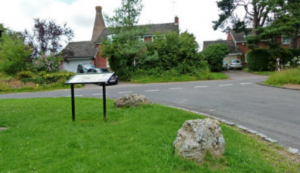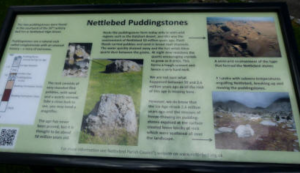

Thought to be more than fifty million years old, these two pudding stones were found in the courtyard of the 16th century Bull Hotel in the High Street. It was also thought that they might have been used as mounting blocks. After the Bull closed the stones were moved to the present location.
************************************
Pudding Stones and the Geology of Nettlebed by Dr. Jill Eyers
Rocks and landscape shaping Nettlebed
As you look around Nettlebed today it is difficult to imagine a time when it was anything else but this beautiful green English village with its lush woodland, common and gentle rolling hills.
Surprisingly, it is the effects of very different environments that have shaped Nettlebed today. Much of the underlying solid rock is Chalk and this was deposited between 95 and 65 million years ago – the result of warm seas and a massive global warming. After 65 million years plate movements gradually moved us northwards and at the same time the global warming gradually came to an end and seas receded. The Lambeth Group sediments (of which the local clays for the brick industry are the most obvious in Nettlebed) were formed by waterlogged soils on a very flat landscape around 50-55 million years ago. Around this time the puddingstones were formed, although we do not yet have a precise date for these rocks. They formed in a hot semi-arid environment within which the sands and pebbly sediments had been deposited by temporary and intermittent rivers. It was not until the Ice Age that this layer was further broken up, with loosened blocks sludging their way down newly formed valleys. If you look carefully you can find the evidence.
Puddingstones on the Common
The first record of the name ‘puddingstone’ appears in 1752 by J. Armstrong (OED) and came into more common usage for the English rounded pebble conglomerate during the Victorian era as a result of its resemblance to the traditional plum pudding served up at Christmas time.
The two puddingstones on the Common were found in the courtyard of the 16th century Bull Inn in Nettlebed High Street. They are undoubtedly local, probably dislodged during the building work. Puddingstones are numerous in this area, but they are also found throughout parts of Hertfordshire, Bedfordshire, Buckinghamshire, Oxfordshire, Wiltshire and Hampshire. All puddingstones have things in common (such as mineral composition), but they can look very different. The age has never been proved, but it is thought to be about 50 million years old.
Puddingstones are a natural rock called conglomerate with an unusual history – a story of extremes. In fact, puddingstones are just one type of deposit that is often called sarsen, but that geologists call silcrete. This type of rock can be either sandy or pebbly. Silcrete by definition is a silica-rich rock (i.e. it has quartz sand and a quartz cement), and some have quartz (flint) pebbles – the puddingstones.
Puddingstone usually consists of very rounded flint pebbles, with sand filling the gaps and held together with a quartz cement. Take a close look to see, you may need a magnifier. The sand grains are well sorted (nearly all the same size) and they have shiny surfaces. These are important clues as to how the rock formed. Glassy grains indicate water transportation (the alternative would be wind transport and these sand grains have matt surfaces).
On the fresher surfaces you can see different colours in the flint pebbles – some are brownish, some are orange-brown and others are a little redder. Some pebbles have a darker coloured ring around the edge. However, as the pebbles begin to weather they get a white crust on them, so the original colour is not easy to see. These rings around the outer edges are caused by exposure to high temperatures, such as being left out in the hot sun for a very long time.
Rocks similar to puddingstone form today only in semi-arid regions such as central Australia, and this was the environment of Nettlebed 50 million years ago. Sudden rainfall carried pebbles and sand in broad river channels. When the water is flowing rapidly the heavier pebbles could be carried with the sand, but as the flow slowed, only sands were transported further on in the channels. The water energy therefore makes the difference between the pure sandy and the pebbly types of sarsen. The fact that sand was also deposited with the pebbles in the Nettlebed puddingstones testifies to very turbulent water action which just dumped a whole lot of sediment together.
The water quickly drains away in these semi-arid environments and the hot winds would then blow quartz dust around, some penetrating between the grains. At night dew moistens the quartz dust encouraging crystals to grow as it dries with the heat the next morning. The result is the toughest natural cement known and hence this is a very hard rock. There are likely to have been multiple phases of forming this silcrete and some may have been formed within the soil profile too.
We are not sure what happened between 50 and 2.6 million years ago as rock of this age is missing here in Nettlebed – although rocks testifying to an estuary and one more flooding by the sea can be found in nearby regions of Oxfordshire and Bucks.
However, we do know that the Ice Age struck 2.6 million years ago and the stresses of freeze-thawing on puddingstones exposed at the surface created loose blocks of rock which were scattered all over the landscape. Sarsen – both the pure sandy kind and the puddingstones have been found as blocks within Reading Formation clays and also Clay-with-Flint. These blocks look as if they have ‘fallen in’ and have probably done almost this – being mobilised along with the other deposits at the end of the Ice Age when sediment is loose and sloppy. Movement downslope is called ‘solifluction’ and mixing under freeze-thaw action in tundra conditions is called
‘cryoturbation’. Both are undoubtedly responsible for movement of the sarsen blocks on valley slopes.
However, people are an erosive force equally as important as natural erosion. We have moved massive amounts of sarsen stones – sometimes out of ploughed fields as they were not wanted there and damaged ploughs, and sometimes loose blocks were taken or deliberately quarried for buildings, or setts for pavements and even quern stones for grinding corn. Sarsen was used in constructing much of Stonehenge and a substantial amount of this rock can be seen in Windsor castle and huge numbers of churches across southern England. In modern settlements you can see many puddingstones marking driveways or in rockeries. The human moving force is quite possibly more massive than the natural processes!
Legends and myths
At one time puddingstone was highly prized for its magical properties. It was said to ward off evil spirits and perhaps this is why it is often found as a single block built into the walls of churches or important buildings. The Saxons often used them as boundary markers (many still mark today’s parish boundaries) and they also form markers in church graveyards.
A legend developed in southeast England that the puddingstones had the ability to reproduce themselves underground. Old terms for the rock were ‘breeding stone’ and ‘mother stone’. In East Anglia it was strongly thought that these stones grew in the soil. In 1887 a clergyman was told by a farmer that it was a waste of time picking the stones off the land as more would grow there. This was a commonly held view in all parts of Oxfordshire and Buckinghamshire – any farmer would tell you how they would just appear from the soil and damage their farm machinery, such as ploughs.
At Stone Farm in Bloxhall, Suffolk, the Blaxhall Stone reputedly grew in a century from a small stone weighing just a pound or so to a 5 ton monster. The eight metre tall monolith by the church in Rudstone, northern England, apparently grew overnight according to local legend.
Further information can be found in:
Simon-Coincon, R., Milnes, A. R., Thiry, M and Wright, M. J. 1996. Evolution of landscapes in northern South Australia in relation to the distribution and formation of silcretes. J. Geol. Soc. London, 153: 467-480.
Hepworth, J. 1997. Those puddingstones. Geologists’ Association circular No. 922, June.
Hepworth, J. V. 1998. Aspects of the English silcretes and comparison with some Australian occurrences. Proc. Geol. Assoc. 109(4): 271-288.
Morley Davies, A. and Baines, A. H. J. 1953. A preliminary survey of the sarsen and puddingstone blocks of the Chilterns. Proc. Geol. Assoc. 64(1): 1-9 & 2 plates.
Nash, D. J., Shaw, P. A. and Ullyott, J. S. 1998. Drainage-line silcretes of the Middle Kalahari; an analogue for Cenozoic sarsen trains? Proc. Geol. Assoc. 109(4): 241- 254.
Potter, J. E. 1998. The distribution of silcretes in the churches of the London Basin. Proc. Geol. Assoc. 109(4): 289-304.
Powell. P. 2005. The geology of Oxfordshire. Dovecote Press.
Sherlock, R. L., Pringle, J, Chatwin, C. P and Pocock, R. W. 1922. The geology of the country around Aylesbury and Hemel Hempstead. Memoirs of the Geological Survey, Explanation of Sheet 238. HMSO.
Summerfield, M. A. and Whalley, W. B. 1980. Petrographic investigation of sarsens (Cenozoic silcretes) from Southern England. Geologie en Mijnbouw 59(2): 145-153.
Ullyott, J. S., Nash, D. J. and Shaw, P. A. 1998. Recent advances in silcrete research and their implications for the origin and palaeoenvironmental significance of sarsens. Proc. Geol. Assoc. 109(4): 255-270.
Sarsens are currently being researched by members of the Bucks Earth Heritage group and so for more information see their website: www.bucksgeology.org.uk
Dr Jill Eyers
Chiltern Archaeology www.chilternarchaeology.com
August 2012